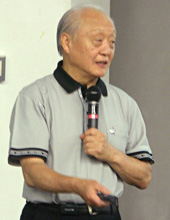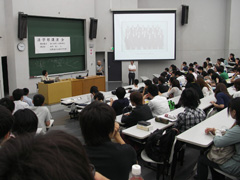Top>Hakumon CHUO [125th Anniversary Issue]>Judge Shunji Yanai of the International Tribunal for the Law of the Sea gives a lecture on the theme of Conflicts at Sea and International Law
 Index
Index
[News Plus]
Judge Shunji Yanai of the International Tribunal for the Law of the Sea gives a lecture on the theme of Conflicts at Sea and International Law
Shunji Yanai, former professor in of the Faculty of Law, and currently a judge at the International Tribunal for the Law of the Sea, gave a lecture (hosted by the Faculty of Law) on July 13 in a classroom in Building No.8 on the Tama Campus. The title of the lecture was Conflicts at Sea and International Law, and the large classroom was jammed with students hoping to work in international institutions as well as students with an interest in international law.

Professor Shunji Yanai giving a lecture
After graduating from the Faculty of Law at Tokyo University, Professor Yanai entered the Ministry of Foreign Affairs, and after serving as head of the Treaties Division, head of the Policy Coordination Division, and foreign affairs councilor, he was appointed Japanese Ambassador to the United States. After retiring from government service, he became a professor in the Faculty of Law and the Graduate School of Law (2002-2007), and has been a judge at the International Tribunal for the Law of the Sea since 2005.
The lecture proceeded with Professor Yanai using a screen, examples, and his wealth of experience as he described the United Nations Convention on the Law of the Sea, and similarities and differences between the settling of territorial disputes at the International Court of Justice (ICJ), the International Tribunal for the Law of the Sea (ITLOS), and the Court of Arbitration.
Professor Yanai first spoke on territory. “When I was a student there were only three types: inland waters, territorial waters (three nautical miles), and international waters.” In the past, he said, territorial waters were set by customary international laws at three nautical miles, a range maintainable by artillary fire.
That was adopted in 1958 by the United Nations Convention on the Law of the Sea in Geneva, with sea territory being codified as inland waters, territorial waters, contiguous zones, continental shelves (to 200 meters), and international waters. Although there was strong pressure to extend territorial waters, there was no agreement on a concrete range, so “fishing disputes, etc. increased.” Then, in 1982 the United Nations Convention on the Law of the Sea was amended to encompass inland waters, territorial waters (12 nautical miles), contiguous zones (up to 12 nautical miles from territorial waters), international straits, archipelagic waters, exclusive economic zones (200 nautical miles from a baseline), continental shelves, and international waters, expanding the realm of jurisdiction of sovereign states. The deep seabed and resources outside of those areas became common human property to be managed at an international level.
As a result, “international conflicts involving sea resources and sea passage increased and continue to this day,” explained Professor Yanai.
Conflicts that arise and cannot be settled through negotiations and mediation between the concerned parties are referred to the International Tribunal for the Law of the Sea (ITLOS), the International Court of Justice (ICJ), or the Court of Arbitration. Referrals to the courts are made with the consent of the parties involved.

The venue for Professor Yanai's lecture was full of students
A common point between the three courts is that they can make legally binding decisions and judgments, but there are also difference.
For example, the ICJ and ITLOS are permanent judicial organizations made up of judges with nine year terms, whereas at the Court of Arbitration arbitrators must be selected with the conflicting countries' consent. This has its merits as the intentions of the conflicting countries can be easily reflected, but it takes a long time before a trial starts. Also, arbitrators require a fee. “The terms of the ICJ and ITLOS are long so it is comparatively easy to maintain justice which is consistent,” says Professor Yanai.
The main difference between the ICJ and ITLOS is that the ICJ is a major UN judicial organization with no restrictions on the international disputes that can be referred to it, whereas ITLOS is a judicial organization established under the United Nations Convention on the Law of the Sea, but is independent from the United Nations.
ITLOS, where Professor Yanai works, is made up of 21 judges, all of whom have different nationalities. “More than anything, the difference in cultures makes it interesting. There are also various religions. We often have tea or eat together. But when it comes around to the time of a hearing, everyone puts on their judge face,” says Professor Yanai, adding a personal experience when introducing the highly cosmopolitan makeup of ITLOS.
There was time taken for questions at the end of the lecture and Professor Yanai gave detailed answers to questions on issues such as the Northern Territories and East China Sea resources.
(Student reporter Mitsuaki Toyofuku, second year student in the Faculty of Letters)
- Research Activities as a Member of Research Fellowship for Young Scientists (DC1), Japan Society for the Promotion of Science (JSPS) Shuma Tsurumi
- Important Factors for Innovation in Payment Services Nobuhiko Sugiura
- Beyond the Concepts of Fellow Citizens and Foreigners— To Achieve SDGs Goal 10 “Reduce Inequality Within and Among Countries” Rika Lee
- Diary of Struggles in Cambodia Fumie Fukuoka
- How Can We Measure Learning Ability?
—Analysis of a Competency Self-Assessment Questionnaire— Yu Saito / Yoko Neha - The Making of the Movie Kirakira Megane








